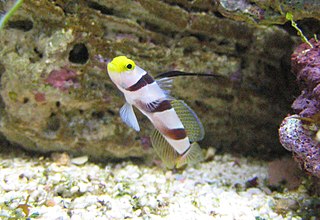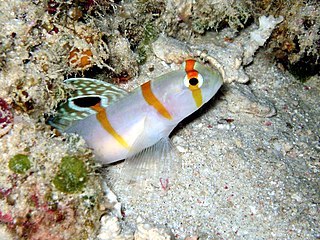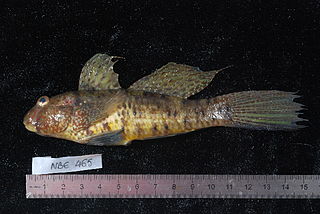
The tiger pistol shrimp belongs to the family of snapping shrimp.

The striped beakfish, also known as the barred knifejaw, is a species of marine ray-finned fish, a knifejaw from the family Oplegnathidae. It is native to the northwestern Pacific Ocean, though a smattering of records exist from other localities in the eastern Pacific such as Hawaii and Chile. It is an inhabitant of rocky reefs and occurs at depths from 1 to 10 m. Juvenile members of this species can be found with patches of drifting seaweed. This species can reach a total length of 80 cm (31 in), with the greatest recorded weight for this species of 6.4 kg (14 lb). The color pattern consists of light and dark vertical bars from which it derives its name. It has been recorded as feeding on hard-shelled invertebrates such as crustaceans and molluscs. It is a commercially important species and is also farmed. It is also sought after as a game fish.

The halloween hermit crab, also known as the striped hermit crab or orange-legged hermit crab, is a brightly colored aquatic hermit crab of the family Diogenidae. Besides its ability to routinely clean algae in aquaria, the halloween hermit crab's festive striped coloration also appeals to enthusiasts; it is considered the most brightly colored hermit crab in normal aquarium use.

Synchiropus splendidus, the mandarinfish or mandarin dragonet, is a small, brightly colored member of the dragonet family, which is popular in the saltwater aquarium trade. The mandarinfish is native to the Pacific, ranging approximately from the Ryukyu Islands south to Australia. It can usually be found in some of the warmer waters.

Stonogobiops nematodes, the Filament-finned prawn-goby, the Antenna goby, the high-fin goby, the red-banded goby, the high-fin red-banded goby, the striped goby, the barber-pole goby, or the black-ray Goby, is a species of marine goby native to the Indian Ocean and western Pacific Ocean from the Seychelles to the Philippines and Bali.

Nemateleotris magnifica, known by a variety of common names including fire goby, magnificent fire fish, fire dartfish, or red fire goby is a species of dartfish native to the Indian and Pacific oceans from the eastern coast of Africa to the Hawaiian Islands and from the Austral Islands north to the Ryukyu Islands. It is an inhabitant of coral reefs where it can be found at depths of from 6 to 70 metres. It is usually found just above the bottom, facing into the current, where it awaits its prey of small invertebrates.

Brachygobius is a small genus of gobies. They are popular aquarium fish where a number of species are sold as bumblebee gobies because their colours are similar to those of bumblebees.

Glossogobius giuris, the tank goby, is a species of goby native to fresh, marine and brackish waters from the Red Sea and East Africa through South Asia and the Indian Ocean to China, Australia and the islands of the Pacific Ocean. This species can also be found in the aquarium trade. It is also known as the bar-eyed goby, flat-headed goby and the Gangetic tank goby.

Valenciennea puellaris, the Orange-spotted sleeper-goby, Orange-dashed goby, or Maiden goby, Diamond Watchman goby, is a species of goby native to the Indian Ocean and the western Pacific Ocean. It inhabits lagoons and outer reefs where it occurs on sandy substrates with larger pieces of rubble to burrow under. It can reach a length of 20 centimetres (7.9 in) SL. It is a prevalent fish in the aquarium hobby. Its main diet is composed of zoo plankton and dead fish or insects.

Amblygobius phalaena, the Sleeper Banded goby, white-barred goby, is a species of goby native to tropical reefs of the western Pacific Ocean and through the central Indo-Pacific area at depths of from 2 to 20 metres. This species feeds by taking in mouthfuls of sand and sifting out algae, invertebrates and other organic matter. It can reach a length of 15 centimetres (5.9 in) TL. It is also of minor importance to local commercial fisheries and can also be found in the aquarium trade.

Amblyeleotris randalli, Randall's prawn goby, is a marine benthic species of goby native to tropical reefs of the central Indo-Pacific. This species can also be found in the aquarium trade.

Elacatinus puncticulatus is a species of goby from the eastern central Pacific Ocean, where it is found on reefs from the Gulf of California to Ecuador. This species occurs at depths ranging from 1 to 21m, and usually in association with the sea urchin Eucidaris thouarsii. The size of the goby varies depending on sex, with females being typically smaller than males, and their geographical location as well as their role as a cleaner goby also has impacts on their morphology. Due to their bright coloration and lack of aggression, the species is commonly found in the aquarium trade.

Eviota pellucida, commonly called neon pygmy goby or pellucida pygmy goby, is a species of marine fish in the family Gobiidae.
Brachygobius nunus, the Golden banded goby, is a species of bumblebee goby, a small genus of gobies that takes its common name from their round bodies, big heads, and their overall yellow to golden coloration interrupted by four brown to black vertical stripes reminiscent of the striped pattern of a bumblebee. They have also been figuratively described as "buzzing" from one surface to another inside the aquarium. Like other members of its genus, it is popular as an aquarium fish.

Amblygobius is a genus of fish in the family Gobiidae found in the Indian and Pacific Ocean.
The comb goby is a species of goby native to marine and brackish waters of the Indian Ocean and the western Pacific Ocean. This species occurs mostly on muddy substrates near mangrove forests. This species grows to a length of 18 centimetres (7.1 in) TL. This species is of minor importance to local commercial fisheries and can also be found in the aquarium trade. This species is the only known member of its genus. Paratrypauchen microcephalus has been recorded from areas which have soft, muddy bottoms, in estuaries and around the mouths of rivers near mangroves where they inhabit deep burrows in the mud. It is not known if they excavate the burrows themselves. This species feeds on benthic invertebrates such as crustaceans.

Amblygobius semicinctus, the halfbarred goby , is a species of goby from family Gobiidae.
Trimma tevegae, commonly known as the bluestripe pygmygoby or blue-striped cave goby among other names, is a species of goby from the western Pacific. They are small fish, averaging at 2 cm (0.79 in), orange-brown with white undersides in life, with characteristic iridescent blue or lavender stripes on the sides and on top of the body. They are usually found in large schools in the sloping or vertical drop-offs at coral reef edges. They are sometimes caught for the aquarium trade, and are also known by hobbyists under the name blue line flagtail goby. The species is named in honor of the schooner Te Vega.

Amblygobius sphynx or the Sphinx goby is a species of goby found in brackish and salt water in the Indo-West Pacific region.
















